New skins versus old wine – A350 or A380?
As the generation of Alpha 200, 300 and 350 reaches early retirement age it may be the time to grab bargains. The new Alpha 230, 330 and 380 have plenty of bonus points to win over new users despite the critical lack of video capture. But the older generation has some very tangible benefits.
The most obvious changes in the ‘Plus-30’ range are the use of a new smaller battery (NP-F50AM) shared with Cyber Shot consumer models, a dual MS ProHG Duo and SD card interface, substantial reduction in weight and size, improved rear LCD screen with auto brightness adjustment (only on the A330 and A380), and a radical overhaul of the graphical user interface to include sample picture tips (pioneered by Nikon).
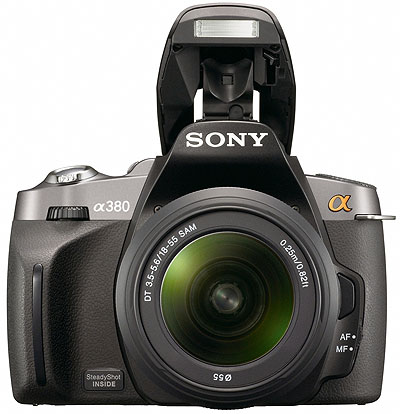
Flash functionality
Probably in order to help the 950mAh battery provide 500 shots under standard test conditions (230 images in Live View mode, A380), the GN of the built-in flash has been dropped to just 10 (m/ISO 100) compared to 12. Note: correcting earlier information – the flash is assumed to be capable of wireless control including wireless HSS. Sony press release information and camera specification tables implied the HVL-F20AM was required for wireless operation. In fact the HVL-F20AM, a new compact flash launched at the same time, only operates in wireless commander mode when fitted to the Alpha 900.
Despite being sold with ‘indoor’ use specified to be bounce flash, the HVL-F20AM’s GN20 is insufficient for bounce shots in most room conditions unless you have an f/2.8 lens and use ISO 800. The HVL-F42AM’s GN42 is more than four times as powerful and can provide enough power for f/5.6 and ISO 400. Small bright rooms allow more flexibility, but issuing an affordable GN 20 gun with a bounce facility is not a clever move for Sony. The resulting underexposure of too many pix will confuse beginners.
The old A200-350 series in contrast offers 50% more power from the inbuilt gun (GN 12 versus GN 10 – remember, it’s a logarithmic scale, GN14 is roughly 2X the power of GN10 – GN20 is four times). It has the same 4 second recycling time, maybe helped by the 1650mAh NP-F500AM battery used in common by all the Sony Alphas from 2007-2008. No attachable gun, not even the HVL-F58AM, can act as a wireless controller on the A200-350 series. If the A230-380 turn out to be compatible with the 58 as a controller, full ratio flash sets could be possible; the information does not make this clear.
The GN20 power is misleading relative to the onboard flash’s GN10. Sony state it has twice the power, but the onboard is rated at 27mm angle of view (18mm APS-C) and the HVL-F20AM is rated at 50mm angle of view. There may be an error somewhere in the specifications, as this would actually mean it was nearly identical is Ws output to the onboard. It has a rotating reflector (like early Braun flashguns) to switch from 27mm to 50mm angle.
The HVL-F20AM appears to be priced at £149 in the UK (source: Amateur Photographer) which seems excessive. The HVL-F42AM is officially priced at £249 but sells for £149.
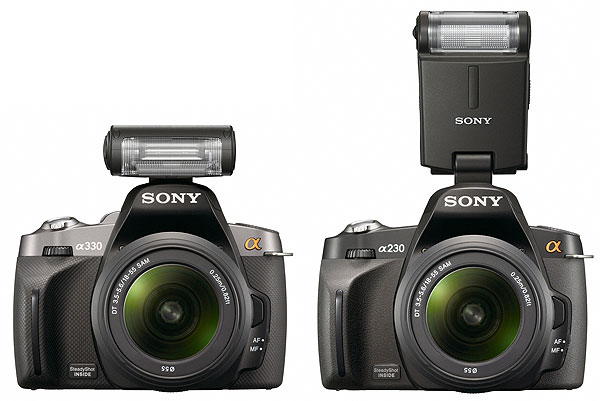
The HVL-F20AM photos show it in two positions, folded down and lifted up. Sorry, all those who thought the ‘down’ position might be a perfect option for macro photography – this folding action is the on-off switch! Fold down, flash off, stored position. Lift up, flash turns on. Note the attractive body finish of the A330, left, and the all-black tasteful simplicity of the A230, right.
Remote Control
The new models are compatible with the remote controller supplied free with the Alpha 700 and 900, the RMT-DSLR1. It’s not supplied with these entry level models; the cost ranges from around £20-40 depending on dealer, in the UK. Since there is no mirror lock-up mode, just a 2sec or 10sec self-timer delay choice, the omission of the socket for a regular remote control cable (a socket design which has been constant from the 1985 Minolta 7000 onwards) may seem a minor point.
But, as ever, it limits options. The ZigView finder attachment with motion sensing video, used to capture animals or objects entering the frame by sensing and triggering, needs the cable connection. So do the PocketWizard and many cheaper wireless frequency long range remote triggers. The RMT-DSLR1 with its additional image playback functions must be used facing the front of the camera, line of sight, from a relatively close position. It won’t work at all in a typical outdoor situation from a distance appropriate for garden wildlife. To set your camera up in front of a nest box or feeding table twenty feet away and trigger shots from a spot where the subject will not be disturbed by your presence needs a more powerful wireless controller.
That option, along with various time-lapse and delay functions found on wireless remotes, is available with the old A200-350 series but not with the new A230-380 series.
Remote-control Continuous is a new feature – set this to shoot 3 or 5 frames at 2.5fps with a single press of the remote. Had there also been a cabled connection this would have been useful for something other than self-portrait or group shots.
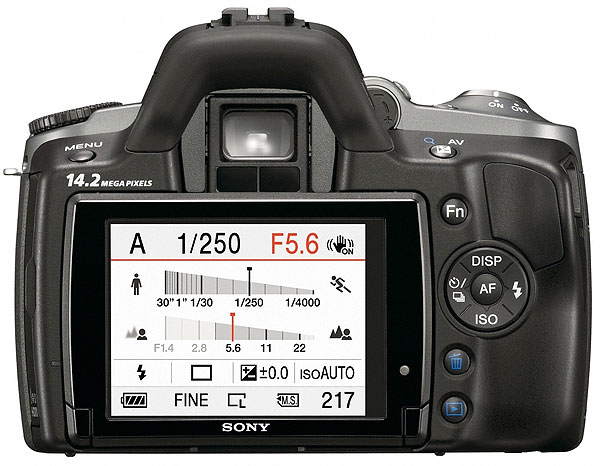
AE Lock
The new models have no AE Lock button. We presume that first pressure on the shutter release in AF-S/AF-A will lock focus and AE, and in MF mode will lock AE. If not, there will no intuitive meter-recompose possibility. The loss of the AE Lock button also means loss of any assigned functions such as AF+AE, AE only etc. Most of the dedicated buttons have disappeared to be replaced by functions on the four-way controller pad (a pad which, in my experience, gets pressed regularly by the joint of my thumb on small camera bodies like this).
White Balance
Custom colour temperature and Tint value settings (manual K and LB values) are axed along with White Balance Bracketing. The earlier series has these choices, the Plus-30s do not. However, Custom WB is retained allowing the use of white or grey cards, ExpoDisc and similar WB aids. We must remember that with the move from the A100 to the A200 series, other semi-pro functions like Mirror Lockup and Depth of Field Preview were lost. These do not make a return. So keeping Custom WB is something to be thankful for.
ISO, DRO, Zones, Auto ISO, NR
The 230-380 series has no Hi/Lo or Zone Matching functions (nor did the A200-350). DRO (Off, Standard, Advanced but no manual control) must do everything. High ISO NR only affects settings of 1600, 2000, 2500 and 3200 ISO – exactly the same as the previous series and like Long Exposure NR can be switched on or off. Auto ISO details are not available but are presumed to be the same as for the earlier models.
Shooting rate
The maximum sequence shooting rate of the A330 and A230 drops to 2.5fps, compared to 3fps in the A300 and A200. The A380 is unaffected and remains at 2.5fps matching the A350, but where the old model would only shoot 4 raw frames at this speed the new one manages 6 frames, matching the A230 and A330. Large fine JPEG shooting is continuous on all models limited only by the card capacity.
Viewfinder
There is no improvement to the viewfinders – a small reduction in eyepoint, by about 1mm, is unlikely to affect most users but spectacle wearers who find the existing models difficult will find things a bit worse with the new design.
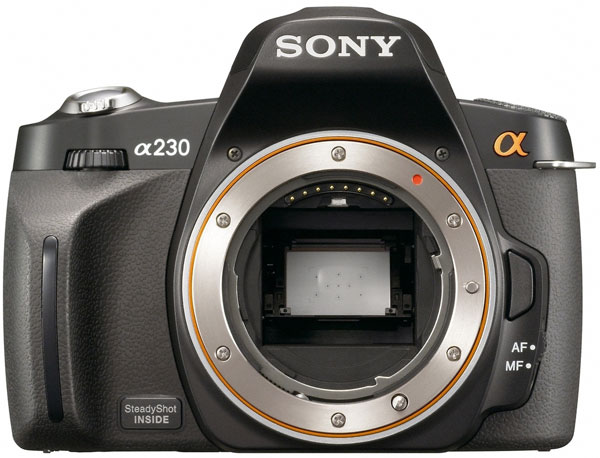
AF Module, AE
Though the specifications for the AF module are identical, the focusing screen appears to be engraved differently if still life shots are to be believed (mock-up LCD screen captures show the old screen markings). The indicator lights are more like spots and the focus zones are shown without orientation of the line sensor. There is no change to the 40-segment metering or the more complex Live View metering. All low light limits, sensor apertures, single versus cross type, etc, are precisely as the older models.
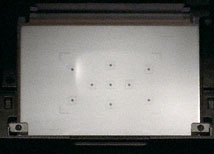
Check those focus markings on the screen. They are not the same as the A200-350 series.
Smart Teleconverter
For the first time, the A230 gains the Smart Teleconverter function according to Sony technical data. There is no longer a function button for this to annoy reviewers. How can it work, at 1.4X and 2X, without Live Preview? The specs for the A330 and A380 also imply that Smart Teleconverter can now be used in optical viewfinder mode. No demonstration animations on Sony sites show this happening. Are there masks or marks? Or is this just an early error in communicating specifications and operation?
Card storage
The new generation uses either SD (including SDHC and the mini-micro variants with adaptors) or MemoryStick Duo (including DuoHG Pro). The twin slots have a switch to change medium, which implies there is no way they can do split raw/JPEG recording, sequential fill-up, double recording backup, or card-to-card copying. However, the hard wired switch is far more convenient than menu diving, and many users will fit a second card to hold their library of personal images, updating this by USB2 connection and use of their computer. New shots on one card, stuff to show people and carry with your permanently on the other.
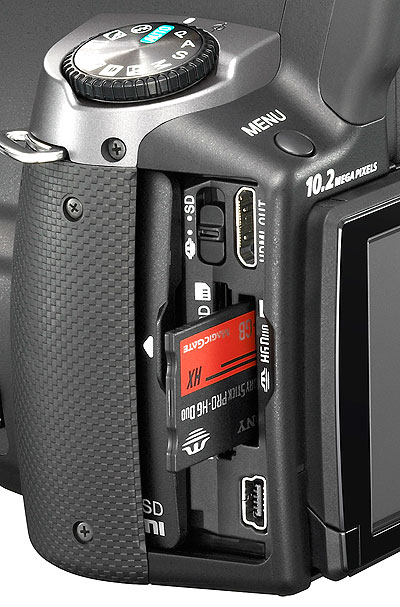
A sliding door, not a hinged one, hides the interfaces and slots. Less vulnerable.
As with the battery issue, if you have an investment in CF cards and simply want to keep everything compatible with other Sony DSLRs you own, buying an A200-350 model might make more sense than buying an A230-380.
HDMI and Bravia
Although the Alpha 700 and 900 can be controlled by their own remote, they do not have Bravia Sync, which enables a Sony Bravia TV handset to control the playback of images via HDMI connection to the camera (see above comment about storing pictures on the second card permanently). They do have PhotoTV, the recognition of the wide colour HDMI 1.3 standard and correct handling of colour profiles by the TV – as do the new models. The A200-350 series lacks any of this and even though capable of 16:9 format shooting, has no HDMI and no way of navigating conventional TV playback except by using the camera’s controls on the body.
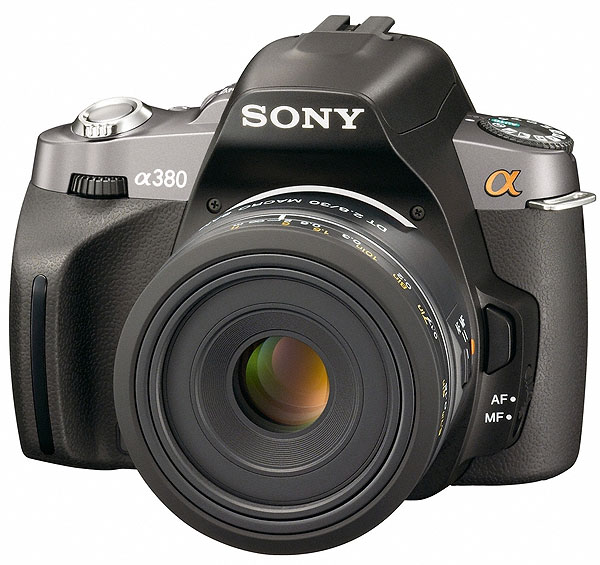
So, in the end, you can weigh up the different functions. The Smart Teleconverter on A230 seems certain to be a specification error. Image quality we can not assess until the cameras appear or arrive for review. Since my own main reviewing work is for professional magazines, and Sony didn’t even bother to invite that section of the press to the launch, I guess we will not be expected to cover it. This website is a different matter and of course I’ll try to put an A380 head to head against my A350.
– David Kilpatrick

I’m totally new to DSLR cameras and I’ve just acquired a new Sony Alpha A230. I was given a M-AFi 2x Teleplus MC7 Converter which also looks like exactly like a Vivitar 2x MC7 AF Converter.
I attached this to my A230 and switched to manual but I get a message saying:- No lens attached, shutter is locked.
Please could someone tell me if I’m doing something wrong with this converter
The teleconverter from this range (Kenko Teleplus) which works with digital cameras is labelled Alpha (symbol) -AF 2X Teleplus MC7, then DG in gold lettering, then Kenko. It has eight contactes on the mount, and it is chipped for use with cameras later than the film Dynax 7 (which earlier models may not necessarily do). You have an older version. But if you want to use it manually, first you need to go into the setup menus of the camera, and set RELEASE W/O LENS to ‘Yes’. I suggest you leave RELEASE W/O CARD left to No.
David
With a smaller battery, I assume the grip will not work on these models.
You can get 32GB SD not sure about MS. 16GB is more common. They are affordable too. The card format is no big deal now but I prefer to have one card type and one reliable FireWire reader for fast transfer, and CF does that for me. I’m always losing SD and MS cards.
David
I have been using 32GB cards in the 350. For me, even a 8GB card were simply to small shooting RAW and Jpeg with this camera.
How big are sd cards? I have not used any in years. A380 shoot the same size files as the 350 right?